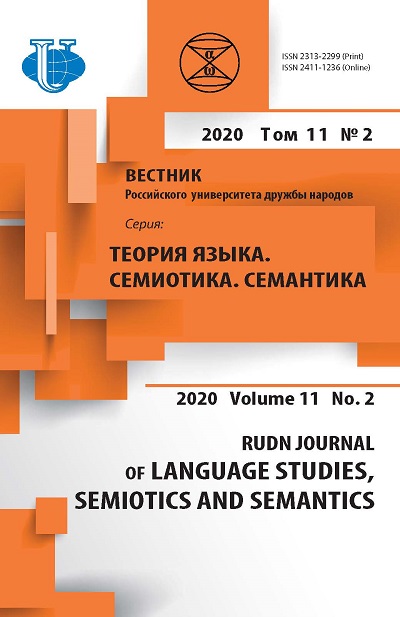Intertextuality of the Small Texts of the French Film Discourse
- Authors: Anisimov V.E.1
-
Affiliations:
- Peoples’ Friendship University of Russia (RUDN University)
- Issue: Vol 11, No 2 (2020): Semantics of Universal and Specific in the Language and a Text
- Pages: 357-367
- Section: SEMIOTICS OF TEXT AND DISCOURSE
- URL: https://journals.rudn.ru/semiotics-semantics/article/view/23587
- DOI: https://doi.org/10.22363/2313-2299-2020-11-2-357-367
Cite item
Full Text
Abstract
This article analyses the intertextuality of the functional and pragmatic elements of the film text (film title, synopsis, slogan) that are a direct part of the film text’s semiotic space. The pragmatic orientation of the film title, synopsis and slogan with their main task (targeted audience capture) largely determines the pragmatic nature of intertextual allusions that occur in these film text elements. The purpose of this work is to prove the presence of intertextual connections in the functional and pragmatic elements of the film text and to consider in depth the internal intertextuality of these elements. In the course of the study, we made the following conclusions: the most acceptable for the analysis of the functional and pragmatic elements of the film text is the theory of transtextuality by G. Genette, through which the intertextuality of the film title, synopsis and slogan must be considered on the basis of the paratextuality, metatextuality and hypertextuality. The intertextuality of the functional and pragmatic elements of the film text consists in the interaction of film title, synopsis and slogan with the precedent texts and events, as well as the intertextual connection inside the class of these elements. The internal intertextuality of the functional and pragmatic elements of the film text allows the movie title, synopsis, and slogan to ensure the fulfillment of their main function that is to attract to watch the movie as many viewers as possible.
About the authors
Vladislav Eu. Anisimov
Peoples’ Friendship University of Russia (RUDN University)
Author for correspondence.
Email: anisimov.vladislav.95@mail.ru
Post-graduate student of the Foreign Languages Department, Philological Faculty
6, Miklukho-Maklaya street, Moscow, 117198, Russian FederationReferences
- Ivanova, E.B. (2001) Intertextuality in feature films [dissertation]. Volgograd. (In Russ.).
- Fedorova, I.P. (2015). Intertextuality in film dialogue. Vestnik Nizhegorodskogo universiteta im. N.I. Lobachevskogo. pp. 320-324. (In Russ.).
- Kristeva, Yu. (1970) Semiotics. Moscow: Moscow State University. (In Russ.).
- Krassina, E.A. & Chesnokova, O.S. (2019). Jorge Luis Borges’s “La Trama”: Evidence of Intertextual Interpretation. Tomsk State University Journal of Philology. pp. 206—223. (In Russ.).
- Alborova, A.A. (2013). To the question of discourse basic parameters on the example of the cinema discourse. Almanac of Modern Science and Education. Tambov: Gramota. No. 9 (76). pp. 14—17. (In Russ.).
- Moliterno, G. (2010). Cinematic Intertextuality and Comic Allusion in Giorgio Mangiamele’s Ninety Nine Per Cent. Screening the past. URL: http://www.screeningthepast.com/2015/01/ cinematic-intertextuality-and-comic-allusion-in-giorgio-mangiamele%E2%80%99s%C2% A0ninety-nine-per-cent/ (accessed: 20.12.2019).
- Serrano, D.H. (2005). Intertextuality and Fidelity in Batman Movie Adaptations. URL: http://www.batman-on-film.com (accessed: 20.12.2019).
- Rachel, J. (2011). Media Intertextuality. URL: www.slideshare.net (accessed: 20.12.2019).
- Krylova, M.N. (2012). Cinema as a source of the intertextuality. Language and social dinamics. All-Russian Conference with international participation proceedings. Krasnoyarsk. pp. 355—361. (In Russ.).
- Gorshkova, V.E. (2014). Film title as a unit of translation and a unit of image-sense. PNRPU Linguistics and Pedagogy Bulletin. No. 10. Perm’. pp. 26–37. (In Russ.).
- Kosikov, G.К. (1994) Ideology, connotation, text (regarding the book “S/Z” by R. Barthes) In: Barthes, R. S/Z. Translated from French by G.K. Kosikov & V.P. Murat. Moscow: “Ad Marginem”.
- Aleksandrova, O.I., Krasina, E.A., Rybinok, E.S. (2019). Precedent phenomena of a film text: feature film title in the terms of translation. Philological Sciences. Scientific Essays of Higher Education. No 5. pp. 22—33.
- Genette, G. (1989). Palimpsests: Literature in the Second Degree. Translated from French. Moscow: Nauka. (In Russ.).
- Slyshkin, G.G., Efremova, M.A. (2004). Film Text (Experience of a culturological analysis. Moscow: Vodolei Publishers. 164 p. (In Russ).
- Intouchables (2011). URL: http://www.allocine.fr/film/fichefilm_gen_cfilm=182745.html (accessed: 22.12.2019).
- Les profs (2013) URL: http://www.allocine.fr/film/fichefilm_gen_cfilm=210211.html (accessed: 22.12.2019).
- La grande boucle (2013). URL: http://www.allocine.fr/film/fichefilm_gen_cfilm=205384.html (accessed: 22.12.2019).
- Edmond (2018). URL: http://www.allocine.fr/film/fichefilm_gen_cfilm=256968.html (accessed: 22.12.2019).
- L’Odyssée (2016). URL: http://www.allocine.fr/film/fichefilm_gen_cfilm=189535.html (accessed: 22.12.2019).













